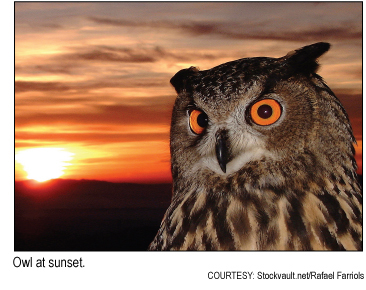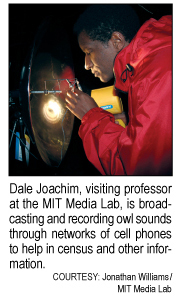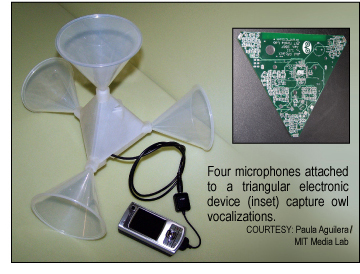|
Profile of Dale Joachim, MIT Media Lab
Nothing to hoot at: Owls may sense changes in the environment
By Lori Valigra
[printer friendly page]
 Dale
Joachim became intrigued when he heard that some birds left New
Orleans before Hurricane Katrina hit in late August 2005. Were
the birds able to sense the impending storm? Dale
Joachim became intrigued when he heard that some birds left New
Orleans before Hurricane Katrina hit in late August 2005. Were
the birds able to sense the impending storm?
“The vocal behavior of birds
may provide information about abrupt changes in the environment,
as can a flock of birds moving,” said Joachim, a visiting
professor at the Massachusetts Institute of Technology’s
Media Lab. Joachim is cooperating with Maine Audubon and others
to study bird vocalizations as part of the Media Lab’s Owl
Project.
He could have used such a warning
system himself. The former assistant professor of computer architecture
at Tulane University in New Orleans was on a cruise in the Gulf
of Mexico before Katrina hit New Orleans. He got home just in
time to evacuate his family.
Now at the Media Lab, Joachim
has developed an experimental electronic sensing device that
can broadcast and record owl vocalizations through cell phone
networks. One goal is to help count the number of owls, a task
traditionally done by humans. That’s a tough job in the
vast wooded expanses in Connecticut and Maine, where his studies
are focused. The device also can monitor climate, and may eventually
answer questions about the hearing range of owls and their responses
to weather or the presence of humans. The device and cell phone
networks could be used for other species of animals as well.
 As
a child, Joachim had traveled the world with his teacher parents.
At one time he lived in Africa, where he felt a strong bond to
nature and animals. But years working at universities and in
industry as an engineer severed his link to animals. As
a child, Joachim had traveled the world with his teacher parents.
At one time he lived in Africa, where he felt a strong bond to
nature and animals. But years working at universities and in
industry as an engineer severed his link to animals.
“After Katrina, I wanted
to focus on something that contributes to a larger picture,”
he said. “As humans, we’re losing track of our connections
with nature.”
Joachim’s approach is to
use technology to augment human activity. The owls he’s
tracking, the Barred owl and the Eastern Screech owl, live along
rural roads. The cell phones are mounted onto tripods set amidst
the trees. Some cell phones have loudspeakers attached to them,
while others have his triangular electronic device about the
size of a human hand with four microphones.
The cell phones play pre-recorded
owl calls through the loudspeakers in an effort to elicit responses
from real owls. The responses from real owls are picked up by
the microphones on the electronic device. Joachim uses multiple
cell phones to get a sense of the direction from which the owl
sounds are coming. The directional information also can separate
different owl sounds. In the future, sophisticated electronic
signal processing technology may make it possible to isolate
a particular owl’s call.
Augmenting humans
Traditionally, volunteers and scientists go into the woods at
night and play pre-recorded owl sounds on a CD or tape recorder.
Joachim’s cell phone device can automate that process, thus
augmenting human owl-monitoring activities. In the spring of
2007, volunteers in Maine Audubon’s Maine Owl Monitoring
Program field tested the cell phone devices along established
survey routes for their owl census. The aim was to get insight
into some long-standing questions about owl survey methodology.
 According
to Maine Audubon, owl detections are much higher when a playback
call is used as opposed to simply having a volunteer sit passively
and listen for owl calls. However, scientists are concerned that
when playbacks are used at one survey point, they may impact
owls further down the survey route, which usually is a rural
road. The new cell phone network technology allows for simultaneous
recordings to be played at multiple points along the road. That
could shed some light on how owls in one area may react to sounds
in other areas. Joachim can control the recording and broadcasting
events via the Web using voice-over-Internet Protocol (voice-over-IP)
technology. According
to Maine Audubon, owl detections are much higher when a playback
call is used as opposed to simply having a volunteer sit passively
and listen for owl calls. However, scientists are concerned that
when playbacks are used at one survey point, they may impact
owls further down the survey route, which usually is a rural
road. The new cell phone network technology allows for simultaneous
recordings to be played at multiple points along the road. That
could shed some light on how owls in one area may react to sounds
in other areas. Joachim can control the recording and broadcasting
events via the Web using voice-over-Internet Protocol (voice-over-IP)
technology.
The Maine study was more extensive
than the pilot census of Connecticut’s owl population conducted
in the summer of 2006. That earlier study showed that the audio
quality of cell phones is sufficient for the discovery and interaction
with owls. The phones, which are small and portable, could potentially
replace the high-quality audio survey broadcasting and recording
equipment currently used.
“This is a way to reconnect
nature and people,” said Joachim. “There is a potential
for education and dissemination.”
For more information visit: The
Owl Project and Maine Audubon.
Lori Valigra is editor of
the Gulf of Maine Times.
|
![]()
